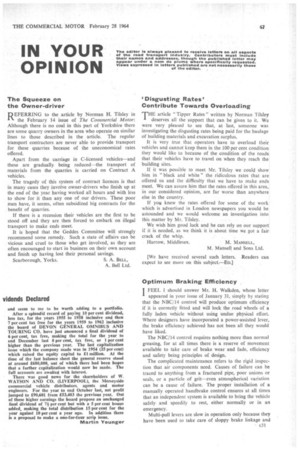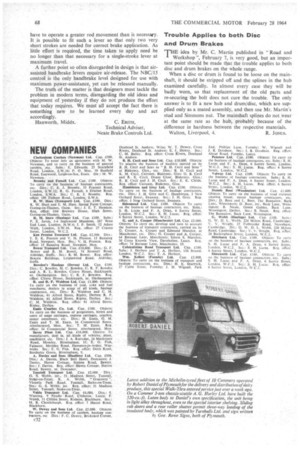Two G000 vidends Declared
Page 68

Page 69

Page 70

If you've noticed an error in this article please click here to report it so we can fix it.
IN his annual review last Apra, stockbroker Sir Ronald 1 G. Leon, Bart., chairman of WEST RIDING AUTOMOBILE CO. stated that the then current trend seemed to indicate better loadings. Was this trend maintained throughout the year to end December last and will it bring a higher payment for shareholders? These are questions which Sir Ronald will, it is assumed, make known towards the end of March when the results are expected to be announced. This company has a remarkably steady earnings and dividend record covering the last decade. 1957 apart, the former ranged between approximately 171 per cent and 111 per cent while the distribution during each of the past four years has been 10 per cent and for the previous five years prior to the 60 per cent capitalization issue made in 1959, it was unaltered at 14 per cent. The fall In net revenue last year was mainly due to passenger receipts being adversely affected by the severe winter. Nevertheless, the results were quite satisfactory. Last September the Interim dividend in respect of the current year was maintained at 4 per cent. I expect to see an unchanged final of 6 per cent. No increase would cause a little disappointment to some. Nevertheless, given this maintained dividend these shares at around their present price of 28s. 60. (they have changed hands at this level recently) return a useful above average £7 Os. 4d. per cent
and seem to me to be worth adding to a portfolio.
After a splendid record of paying 10 per cent dividend, less tax, for the years 1955 to 1958 inclusive and then 7 per cent tax free for the years 1959 to 1962 inclusive the board of DEVON GENERAL OMNIBUS AND TOURING CO. have just anounced a final dividend of 6 per cent, tax free, making the total for the year to end December last 8 per cent, tax free, or 1 per cent higher than the previous year. The last capitalization issue which the company made was in 1954 (25 per cent) which raised the equity capital to £1 million. At the time of the last balance sheet the general reserve stood at around £680,000, out of which there had been hopes that a further capitalization would now be made. The full accounts are awaited with interest.
There was good news for the shareholders of %V. WATSON AND CO. (LIVERPOOL), the Merseyside commercial vehicle distributors, agents and motor engineers. For the year to end October last, net profit jumped to £90,601 from £53,403 the previous year. Out of these higher earnings the board propose an unchanged final dividend of 71 per cent but with a 5 per cent bonus added, making the total distribution 15 per cent for the year against 10 per cent a year ago. In addition there is a proposal to make a one-for-four scrip issue.
Optimum Braking Efficiency I FEEL I should answer Mr. H. Walkden, whose letter I appeared in your issue of January 31, simply by stating that the NBC/14 control will produce optimum efficiency if it is correctly fitted and will lock the road wheels of a fully laden vehicle without using undue physical effort. Where designers have incorporated a power-assisted lever, the brake efficiency achieved has not been all they would have liked.
The NBC/14 control requires nothing more than normal greasing, for at all times there is a reserve of movement available to take care of brake wear and fade, efficiency and safety being principles of design.
The complicated maintenance refers to the rigid inspection that air components need. Causes of failure can be traced to anything from a fractured pipe, poor unions or seals, or a particle of grit—even atmospherical variation can be a cause of failure. The proper installation of a manually operated handbrake control ensures at all times that an independent system is available to bring the vehicle safely and speedily to rest, either norrnallY or in an emergency.
Multi-pull levers are stow in operation only because they have been used to take care of sloppy brake linkage and have to operate a greater rod movement than is necesswy. It is possible to fit such a lever so that only two very short strokes are needed for correct brake application. As little effort is required, the time taken to apply need be no longer than that necessary for a single-stroke lever at maximum travel.
A further point so often disregarded in design is that airassisted handbrake levers require air-release. The NBC/15 control is the only handbrake level designed for use with maximum power-assistance, yet can be released manually.
The truth of the matter is that designers must tackle the problem in modern terms, disregarding the old ideas and equipment of yesterday if they do not produce the effort that today requires. We must all accept the fact there is something new to be learned every day and act accordingly.
Hanworth, Middx. C. ERITH, Trouble Applies to both Disc and Drum Brakes THE idea by Mr. C. Martin published in "Road and Workshop ", February 7, is very good, but an important point should be made that the trouble applies to both disc and drum brakes on the whole range.
When a disc or drum is found to be loose on the mainshaft, it should be stripped off and the splines in the hub examined carefully. In almost every case they will be badly worn, so that replacement of the old parts and re-securing the bolt does not cure the trouble. The only answer is to fit a new hub and drum/disc, which are supplied only as a mated assembly, and then use Mr. Martin's stud and Simmons nut. The mainshaft splines do not ,wear at the same rate as the hub, probably because of the difference in hardness between the respective materials.
Walton, Liverpool, 4. R. JONES.












































































































